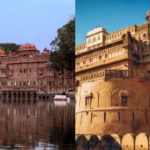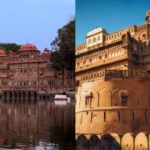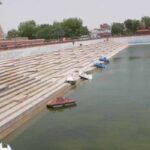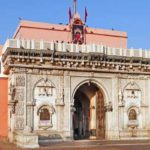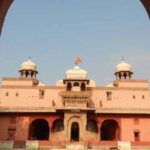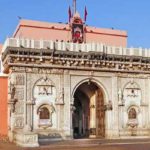Junagarh Fort Bikaner, located in the city of Bikaner, stands proudly as a symbol of invincibility. Originally called “Chintamani Mahal” until the 20th century, it was subject to repeated invasions in the past, but remained unconquered over time. It got its present name, Junagarh, which means “Old Fort”, in the early 20th century, when the royal family shifted to Lalgarh Palace. This is one of those few forts in Rajasthan which is not seated on a hilltop. Rather, the modern city of Bikaner was built around the fort.
Its believe that the first digging ceremony of the fort was held on 30th January, 1589 AD, while the foundation was laid on 17th February, 1589 AD. The construction of the fort is said to have been completed on 17th January 1594 AD. This fort represents architectural excellence and is a great center of art, heritage, culture and history.
The structures found in the Junagarh Fort Bikaner are palaces and temples, which are primarily built of red sandstone and marble. The palaces, with their courtyards, kiosks, balconies and windows, allure visitors in large numbers. Most of these have been converted as museums and provide a valuable insight into the royal lifestyle of the erstwhile princes and rulers of Rajasthan.
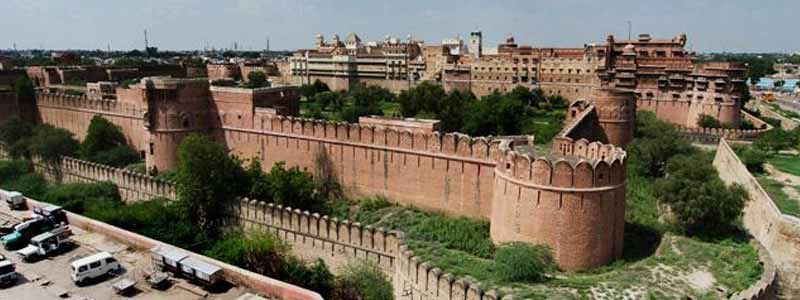
History of Junagarh Fort
The foundation of the Junagarh Fort Bikaner was laid by Rao Bika in 1478. Earlier it was just a stone fort. The present Junagarh fort was built to protect the stone fort built by Bika. The city of Bikaner was established in 1472 and grew up around the mighty fortress. There were many attempts to capture it by foreign enemies. However, all except one failed. Kamran Mirza, the son of Babur, captured the striking fort just for one day in 1534 during the rule of Rao Jait Singh.
The city of Bikaner flourished under the rule of its sixth ruler Raja Rai Singh who ruled from 1571-1611. Raja Rai Singh accepted the Mughal rule and held high position under the rule of Akbar and Jehangir. His victories in various wars won him many accolades and jagirs. After gaining position under the Mughal rule, Raja Rai Singh started building the Junagarh fort. The foundation ceremony of this impressive fortress was held on 17th February 1589, and the work was completed on 17th January 1594. Raja Rai Singh, who was an artistic person and had knowledge of architecture, designed the fort to be a grand structure amidst the Thar Desert.
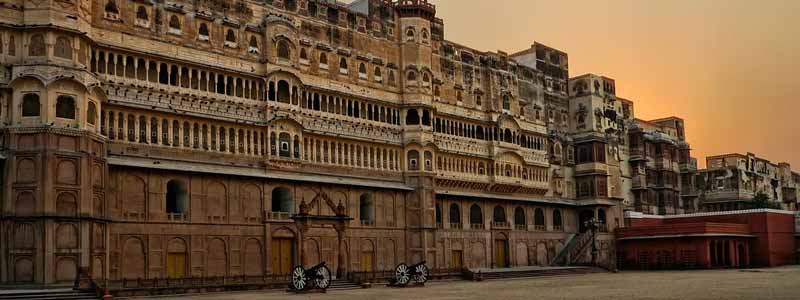
Architecture of Junagarh Fort
The Junagarh Fort Bikaner is an epitome of architectural excellence. The architecture is a mix of various cultures, the earliest being the Rajput style. The earliest smear of design is that of the traditional Rajput style influenced by the alliance of the Gujarati association with the Mughals. Next, the architecture reflected semi-western influence and lastly the revivalist Rajput structures built mainly during the rule of Maharaja Ganga Singh.
The Junagarh fort has a rectangular layout with a length of about 1078 yards. It encloses an area of 63119 square yards. The fort was initially built as a safeguard to the old stone fort built by Rao Bika. It used to have a moat earlier for security purposes, but it is now non-existent. The magnificent fortress encloses many palaces with exquisite designs. All the balconies, gates, kiosks and other structures have been influenced by the heritage and culture of the ruler who built them.
One of the main features of Junagarh Fort Bikaner is the stone carvings done in red and gold sandstone. All the structures are made of red sandstone. The interiors are decorated as per ancient Rajasthani style. The palatial fort has seven gates with many palaces as well as Hindu and Jain temples. It also has two main gates made of Golden sandstones. Earlier the Karan Pol was used for entry while the Suraj pol is used now. The Karan pol is east facing which allows the first rays of the sun to fall on it. The golden rays on the yellow sandstone is a beautiful vision and are also considered a good omen.
The lavish structures of this fort and the exquisite beauty of each structure stand witness to the regal lifestyle that had been led here centuries ago. The Junagarh Fort is called “a paradox between medieval military architecture and beautiful interior decoration Bikaner Attractions.
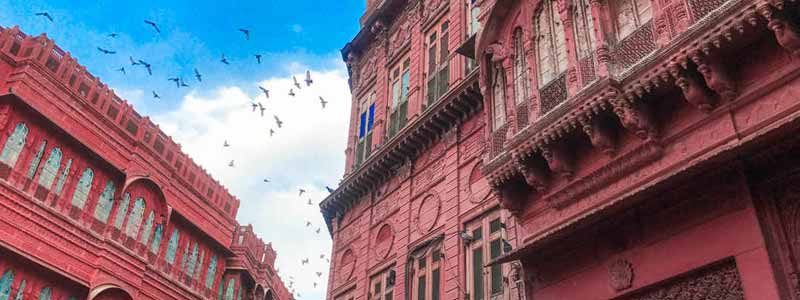
Best Time to Visit
The best time to visit any place is when you could feel fully comfortable exploring it without the impact of weather conditions. Junagarh Fort Bikaner is located in the middle of the Thar Desert, where summers are hot. Therefore, it is recommended that the tourists visit Junagarh Fort during the cooler months from November to February.
Junagarh Kila, Bikaner is a wonderful destination for a fun-filled day outing in Bikaner. Owing to the importance and the appeal of the place, it is the main destination in all Bikaner tour packages. On a trip to the fort, remember to carry water, wear comfortable shoes, and apply sunscreen as you will have to walk a lot to explore the place.
How to Reach Junagarh Kila, Bikaner
To reach Bikaner from other cities, the best option is to travel via road. RSRTC buses run to Bikaner from cities like Jaisalmer, Udaipur, Ajmer, and Delhi. It is also convenient to travel to the city by air. The nearest airport is Jodhpur, which has many flights from Mumbai and Delhi.
Junagarh Kila in Bikaner enjoys easy accessibility from all points in Bikaner. Located at the heart of the city, the fort can be easily reached by car, bus, cab, or even auto rickshaw. Public buses also run from different points in the city to the fort.
By Air : Bikaner airport is recently opened in 2014. The airport is 13km away from the city. Currently no flight arrives to or depart from the airport but the government is trying to start some flights soon. The nearest airport to Bikaner is Jodhpur. People can reach Jodhpur by air and from there they can reach Bikaner by train or by taxi.
By Train : Bikaner is connected to many cities by train as many long and short-distance trains start from Bikaner or go to other cities via Bikaner. No Rajdhani, Shatabdi, or Garib Rath trains run from the city but superfast trains and fast mail and express trains connects Bikaner to various cities. Bikaner is connected to Delhi, Mumbai, Chennai, Kolkata, Jaipur, Jodhpur, Jaisalmer etc. by rail transport.
By Road : Bikaner is well-connected to different cities via road transport. Tourists can either book a taxi or catch state-owned or private buses to go to nearby cities from Bikaner. Tourists can get direct buses to Delhi, Jaipur, Agra, Ahmedabad, Pune, Jodhpur, Mumbai, Jaisalmer, and many other cities.

